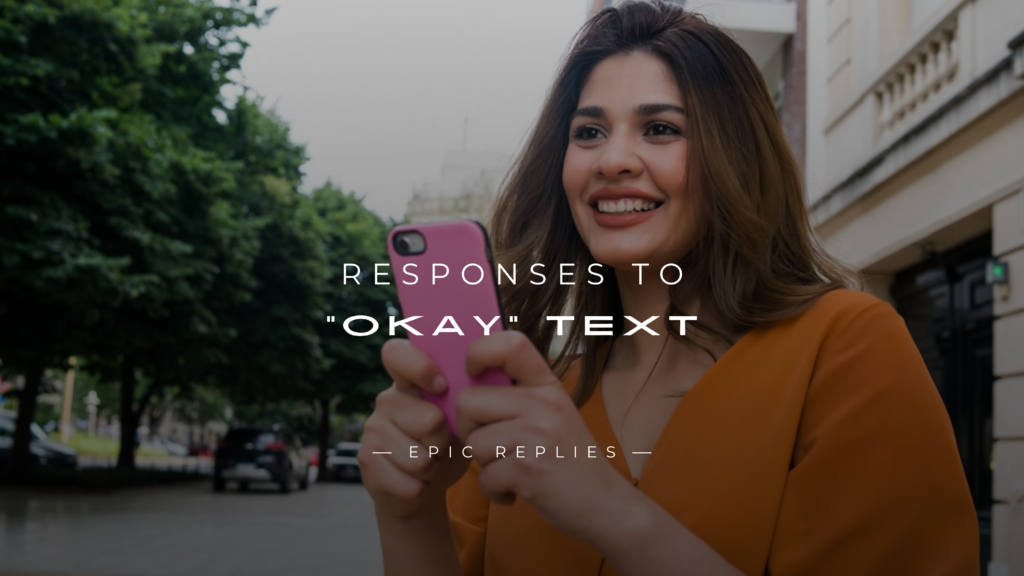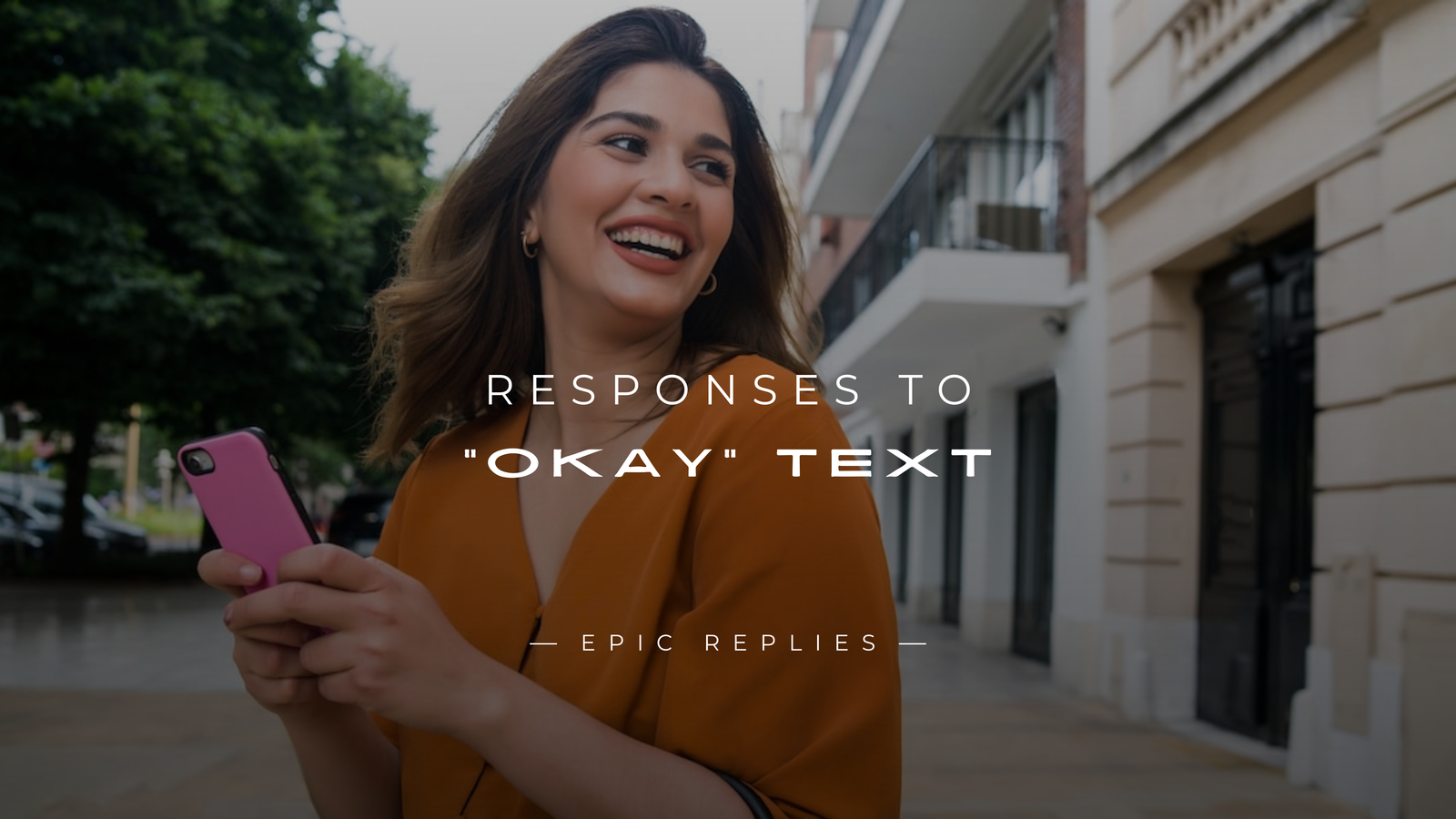Imagine this. You send a heartfelt message or maybe a thoughtful response, or even just a well-crafted plan for the weekend. You wait for their reply, curious or maybe even excited. Then it comes.
“Okay.”
No emoji. No punctuation. No feeling.
It’s one of the most common replies in digital communication, and also one of the most confusing. A simple “Okay” text can either be a confirmation, a passive-aggressive response, or a plain signal that the other person is not interested in continuing the conversation. The problem? You’re often left guessing.
If you’ve ever been thrown off or even mildly offended by receiving a one-word “Okay” text, you’re not alone. Let’s dig into the psychology, situations, and smart ways to respond, without falling into overthinking spirals or unnecessary anxiety.

250+ Responses to “Okay” Text
Cheerful Agreement
- Great, sounds good to me!
- Yay, glad we’re aligned!
- That works perfectly!
- Awesome, thanks!
- Sweet! Let’s do it.
- Okay, love it!
- That’s what I was hoping for.
- Cool, moving forward then!
- Happy to hear that!
- Perfect, thanks for confirming!
Encouraging Follow-up
- Let’s keep it rolling!
- Awesome, what’s next?
- Cool, any updates on your end?
- Nice, keep me posted!
- Sounds good, let’s finish strong.
- Love it. Let me know how it goes.
- Okay, wanna chat more about it?
- Great, I’m excited for what’s next!
- Let me know if you need help with anything.
- Looking forward to your next message!
Affirmation + Next Step
- Got it, I’ll handle the rest.
- Okay then, I’ll get started.
- Cool, I’m locking it in.
- Okay, I’ll send that over.
- Great, I’ll go ahead and schedule it.
- Okay, I’ll let them know.
- Sounds good, I’ll follow through.
- Alright, next step is on me.
- Cool, working on it now.
- Perfect, I’ll take it from here.
Chill Acknowledgment
- Cool cool.
- Aight.
- Bet.
- Gotchu.
- All good.
- Word.
- Say less.
- Sure thing.
- Dope.
- Alrighty.
Simple Echo
- Okay then.
- Okay cool.
- Okay got it.
- Okay sure.
- Okay okay.
- Okay lol.
- Okay yes.
- Okay I see.
- Okay thanks.
- Okay bro.
Thumbs-up Emoji
- 👍
- 👍🏻
- 👍🏽
- 👍🏾
- 👍🏿
- 👌👍
- 👍 Gotcha
- 👍 Sounds good
- 👍 Will do
- 👍 Cool with me
Sarcastic Play
- Wow, such enthusiasm.
- Don’t get too excited or anything.
- Calm down, it’s just “okay.”
- Geez, try not to sound so thrilled.
- That was… overwhelming.
- Riveting. Truly.
- “Okay” huh? That’s all I get?
- What a passionate response.
- I felt that “okay” in my soul.
- You sure you’re not jumping for joy?
Over-the-Top Enthusiasm
- OHHH YEAHHH!
- OKAAAAYYY LET’S GOOOO
- OMG YESSSSS
- That’s what I’m talking about!!!
- WOOHOOO
- Big OKAY energy!
- Let’s freaking DO THIS
- THE HYPE IS REAL
- YAAAAY OKAYYYY
- I’M READY, BORN READY
Meme Response
- Sends GIF of SpongeBob saying “Okay”
- Michael Scott: “Okay? Okay!”
- Grumpy Cat with “Okay.” caption
- Patrick Star nodding slowly
- Jim Halpert doing the camera stare
- Kermit sipping tea: “Okay.”
- Drake face meme: “Okay > Anything else”
- Minion giving thumbs up with “Okie Dokie”
- TikTok sound: “Okayyy and what about it?”
- “It is what it is” meme
Questioning Tone
- Just okay?
- That’s it?
- Okay how?
- You sure that’s all?
- What do you mean by “okay”?
- Was that a good okay or a bad one?
- Are we good though?
- Is that a “fine” okay or a “happy” okay?
- Hmm… okay?
- That sounded hesitant something up?
Curious Probe
- Can you tell me more?
- Okay… but what’s really on your mind?
- Want to elaborate on that?
- Mind explaining a bit?
- Are we all clear or should we dig in more?
- You sure? Anything you’re not saying?
- Should I be reading between the lines?
- You good?
- You wanna talk more about it?
- That okay feels loaded what’s up?
Uncertain Reassurance
- Okay… you sure that’s really how you feel?
- Alright, just making sure you’re actually good with that.
- Hmm, that sounded a little unsure everything cool?
- Okay, but I’m here if you want to talk more.
- Okay, but I sensed a pause behind that.
- Just checking are you totally okay or just saying that?
- If that “okay” changes later, it’s all good to speak up.
- Alright, but don’t feel like you have to settle.
- You don’t have to say “okay” if you’re not.
- Alright, but that sounded kind of off. Want to clarify?
Ask for Clarification
- Okay… as in yes?
- What do you mean exactly?
- Do you mean you agree or you’re just acknowledging?
- Just to be clear, are we on the same page?
- So, is that a go-ahead?
- Can you clarify what “okay” means here?
- Okay how?
- Are you good with the plan?
- Okay cool, but want to elaborate?
- Should I take that as a green light?
Prompt Action
- Alright, I’ll get moving then.
- Okay, sending it over now.
- Got it, will handle it right away.
- Cool, I’ll start working on it.
- Okay, booking it now.
- Sounds good, I’ll go ahead.
- Alright, on it.
- Perfect, I’ll make it happen.
- Okay, you’ll have it shortly.
- Got it, give me a few minutes.
Check Mood
- You alright? That okay sounded a bit dry.
- Everything good with you?
- That okay came with a vibe what’s up?
- Hey, are you sure you’re fine?
- You feeling off?
- Just checking how are you really?
- You okay okay or just texting “okay”?
- Talk to me, you good?
- That didn’t sound like your usual self.
- Want to share what’s on your mind?
Empathetic Check-in
- I’m here if you want to unpack that “okay.”
- You don’t have to explain if you’re not ready, but I’ve got you.
- If “okay” is all you’ve got right now, that’s fine just know I care.
- Sounds like something might be up wanna talk about it?
- Take your time. I’m listening when you’re ready.
- No pressure, but I’m here if you want to share.
- That okay felt a little heavy. Sending you support.
- I’m holding space for you, just in case.
- If you’re going through something, I’ve got you.
- You don’t have to say more unless you want to, but I’m here.
Supportive Vibe
- You got this.
- Whatever you need, I’m with you.
- That okay sounds like you’re trying proud of you.
- I’m just a message away, no matter what.
- You don’t have to go through it alone.
- I’m cheering you on from here.
- Your feelings are valid even if you just say “okay.”
- I’m always in your corner.
- I’ve got your back, truly.
- We’ll figure it out together.
Relationship Context
- That’s not your usual “okay,” you sure we’re good?
- When you just say “okay,” I wonder what’s really going on.
- Okay… but it feels like something’s off between us.
- Is that a “we’re fine” okay or a “let’s move on” okay?
- Talk to me, babe. That didn’t sound like your heart was in it.
- I love you even if you’re feeling meh.
- I know you what’s under that okay?
- We don’t have to pretend. Tell me what’s really up.
- You matter to me way more than a one-word text.
- I’m here, and I care even when you go quiet.
Professional Confirmation
- Noted, thank you.
- Understood, proceeding accordingly.
- Acknowledged. Let me know if you need anything further.
- Copy that, I’ll move forward.
- Confirmed. I’ll follow up as needed.
- Message received.
- Okay, marked on my end.
- Thanks for the confirmation.
- Okay, we’re aligned.
- Acknowledged. I’ll take it from here.
Next Steps Confirmation
- Great, I’ll send over the docs next.
- Okay, I’ll follow up tomorrow.
- Perfect, I’ll schedule it.
- Alright, next up is the handoff.
- Thanks next step is on me.
- Got it, I’ll prepare the report now.
- Awesome, I’ll take care of the next move.
- Okay, I’ll be waiting for your update.
- Let me know when you’re ready for the next part.
- Cool, I’ll draft a summary and share it.
Polite Response
- Alright, thank you for letting me know.
- Okay, appreciate the update.
- Understood, thank you.
- Okay, sounds good to me.
- Got it, I’ll take note.
- Okay, thanks again for your time.
- Okay, feel free to reach out if anything changes.
- Thanks, I’ll proceed as discussed.
- Okay, appreciate your confirmation.
- Great, let’s keep in touch.
Bored Reply
- Fascinating.
- Riveting stuff.
- Wow, thrilling.
- Oh joy, another “okay.”
- I can barely contain my excitement.
- You really know how to keep a conversation alive.
- I’ll try not to get overwhelmed.
- Please, slow down. That was too intense.
- Okay. Cool. Whatever.
- Yawn. Got it.
Playfully Dramatic
- That’s all I get? Just “okay”?
- You wound me with such a dry response.
- The drama! The suspense! And then… just “okay.”
- I poured my soul into that and you say “okay”?
- Okay? OKAY? That’s it?
- I waited all this time… for an “okay”?
- Your energy is unmatched. Truly.
- I don’t know how to recover from that response.
- That okay shook me to my core.
- This is how legends reply.
Reverse Uno
- No… okay you.
- Okay? Nah, okay me.
- I see your okay and raise you a “sure.”
- Okay right back at ya.
- You said okay, but I was gonna say the same.
- We’re both just okay now, huh?
- I was literally about to say that.
- Beat you to it in my head.
- Okay? That’s my line.
- Hey, I said okay first!
Silent Acknowledgment
- ✅
- 👌
- 🙂
- 👀
- ✌️
- 😌
- 🙏
- ✔️
- 🫡
- 👂
Understanding the “Okay” Text
- Why a Simple “Okay” Can Feel So Complicated
In the world of texting, where tone and facial expressions are missing, the word “Okay” sits in an awkward gray area. It’s technically a positive or neutral reply. But emotionally, it can feel like a verbal shrug. It offers no energy, no emotional confirmation, and no sense of continuation.
What makes it complicated is that “Okay” can mean different things depending on who sent it, why they sent it, and what came before it. Sometimes it means “I agree.” Other times it might mean “I don’t want to argue with you.” It could even mean “I’m not interested, but I don’t want to say it out loud.”
- Emotional Impact of a One-Word Reply
Receiving a one-word reply like “Okay” after sharing something meaningful can feel incredibly dismissive. It can make you feel unheard or even insulted, especially when you were expecting an enthusiastic or thoughtful response.
This emotional reaction is valid. Humans are wired for connection, and when that connection feels cut off or minimal, our brains interpret it as a social threat. That’s why even a tiny word like “Okay” can cause a big internal reaction.
- Different Intentions Behind an “Okay”
Before jumping to conclusions, it’s important to remember that not everyone puts emotional depth into texting. One person’s “Okay” might truly mean “I agree” or “Sounds good” while someone else might use it as a way to brush off the conversation.
Some people are straightforward and minimal in their communication. Others are more expressive and detailed. Understanding your contact’s communication style can help you interpret what they actually mean.
Decoding the Tone of an “Okay” Text
- “Okay” vs “K” vs “Ok” – What’s the Difference?
The way someone types “Okay” can drastically change how it’s received.
“Okay” spelled fully often comes across as more polite or neutral. It suggests that the person took a moment to type it out rather than just firing back a knee-jerk reply.
“Ok” is more casual and frequently used in quick or informal texting. It can feel slightly lazier or less thoughtful but often means the same thing as “Okay” with less emotional weight.
“K” is usually the most charged version. Many people interpret it as cold, annoyed, or even passive-aggressive. It’s often seen as a way of ending the conversation abruptly or expressing disapproval without getting into an argument.
Then there are playful versions like “Okaaaay” or “Okiii” which are often lighthearted or sarcastic, depending on the relationship between the people texting.
- Context is Everything
Context changes everything. If you’ve been chatting casually and someone replies with “Okay,” it may simply be the natural end of that exchange. But if you just poured your heart out or shared something vulnerable, and all you get is “Okay,” it might sting more.
Think about what came before the “Okay” and the kind of relationship you have with the person. If they’re usually expressive and suddenly send a dry “Okay,” it might indicate a shift in mood or interest.
- Look at the Timing and Frequency
Timing is another major clue. Was the “Okay” text sent right away, or after a long pause? A quick response might indicate the person is just being efficient or busy. A delayed one-word reply can feel dismissive.
Also, look at the pattern. If someone constantly sends one-word responses with little effort, that’s a different situation than a normally engaged person who just had a low-energy moment.
Common Scenarios Where You Might Get an “Okay” Text
- After a Long Paragraph
If you send a long message explaining your thoughts, feelings, or ideas, and the reply you get is simply “Okay,” it can feel like a slap in the face. It might leave you wondering whether they even read your message or cared at all.
Sometimes, people don’t know how to respond to emotional content. Others might be avoiding conflict or trying not to escalate a situation. In those moments, “Okay” becomes a placeholder for all the things they’re not ready to say.
- During a Conflict or Argument
In the middle of a disagreement, “Okay” can mean a lot more than just agreement. It might signal emotional shutdown, surrender, or even sarcasm. It’s often used to disengage from the conversation or avoid further confrontation.
If the tone was heated before that message, “Okay” probably doesn’t mean “I agree with you.” It likely means “I don’t want to fight anymore, but I’m still not happy.”
- When Making Plans
This is where “Okay” can be pretty harmless. You suggest a plan and they respond with “Okay.” It’s probably just their way of confirming. Still, if you’re hoping for excitement or enthusiasm, a flat reply can be a letdown.
If they follow up with questions or specific suggestions, that’s a good sign. If not, you might want to check in and see if they’re really on board or just going along with it to avoid saying no.
How to Respond to an “Okay” Text Without Overthinking
- Step Back and Breathe First
Before you start rereading your message or panicking over what went wrong, take a moment to breathe. Overthinking is a natural response, especially when communication feels ambiguous, but it doesn’t help.
Give yourself a moment of distance so you can approach the situation with a clear head. Not every short reply is a sign of rejection or a deeper issue.
- Consider Their Personality and Communication Style
Think about how they usually text. Are they often brief or emotionally distant in messages? If so, their “Okay” might just be their version of a green light.
On the other hand, if they’re normally warm and suddenly go cold, it might be worth checking in with them gently.
- Don’t Jump to Conclusions
Just because you feel unsettled doesn’t mean something is wrong. Text messages are limited. They strip away vocal tone, body language, and facial expressions. Sometimes, people are just distracted or multitasking when they text.
Give them the benefit of the doubt unless you have other reasons to believe something is off.
Best Responses to an “Okay” Text Based on Situation
- When It’s From a Friend
Friends often get casual with one another, but if you feel like you were brushed off, try injecting a little humor or curiosity into your response.
Examples:
“That’s it? Just okay?”
“Glad you’re so thrilled!”
“Need a nap or something?”
This keeps the conversation open and adds personality without coming across as demanding.
- When It’s From a Partner or Crush
Romantic situations carry more emotional weight. If you get an “Okay” from someone you’re dating or hoping to date, it can be nerve-wracking. But again, your response should be calm and curious, not confrontational.
Examples:
“Hey, just checking in. Everything good?”
“You seem a little quiet. Something on your mind?”
These responses invite honesty without pressure.
- When It’s From a Co-Worker or Boss
In professional settings, “Okay” is usually just a confirmation. There’s no need to read too much into it unless the tone or timing suggests a problem.
Professional replies might include:
“Thanks for confirming. Let me know if you need anything else.”
“Great, moving forward with the plan.”
Short, polite, and efficient responses work best in workplace communication.
Turning the Conversation Around
- Ask a Follow-Up Question
If you want to keep the conversation alive, asking a follow-up question is a great strategy. It encourages engagement and shows that you’re interested in continuing the chat.
For example:
“Okay cool. So what time are we thinking?”
“Got it. Are you excited about it?”
- Use Humor or Light Sarcasm
If you share a friendly relationship, you can use playful sarcasm to bring the energy back.
Examples:
“Such enthusiasm. Try not to sound too excited.”
“I’m overwhelmed by your passion.”
This works well with people who understand your sense of humor. Be cautious with those who might misinterpret it.
- Acknowledge It and Move On
Sometimes the best thing to do is just move forward. If “Okay” feels like a dead end, pivot to a new topic or wrap up the conversation.
For example:
“Alright, cool. By the way, did you see that movie I mentioned?”
This keeps things flowing without fixating on the dry reply.
When Silence is the Best Response
- Letting It Be When the Conversation is Over
Not every text requires a response. If the conversation has naturally ended, a simple “Okay” might just mean “we’re done here.” That’s perfectly okay.
If you’re not sure what to say and feel no emotional urgency, silence is completely acceptable.
- Using Silence to Set Boundaries
If someone consistently gives you dry or dismissive replies, it’s okay to take a step back. You don’t owe constant energy to someone who isn’t matching yours.
Silence can be a respectful way of signaling that you expect more meaningful engagement.
The Psychology Behind Short Texts
- Are They Dismissing You or Just Busy?
People live busy lives. A short reply might reflect someone’s attention being pulled in other directions. It doesn’t always mean disinterest or annoyance.
Assume positive intent unless you have repeated experiences telling you otherwise.
- Attachment Styles and Texting Habits
Texting behavior often reflects deeper personality traits and attachment styles. Avoidant people might prefer shorter replies because they value independence and find emotional texting uncomfortable. Anxiously attached people may crave constant affirmation and feel hurt by brief messages.
Understanding this can help you interpret your feelings and theirs more accurately.
Avoiding Miscommunication in Texting
- Be Clear With Your Intentions
If something is important to you, be direct. Say what you mean and avoid vague hints. This prevents misunderstandings and helps others know how to respond appropriately.
- When to Pick Up the Phone Instead
If the tone feels off or if you’re unsure where things stand, a quick call can clear everything up. Hearing someone’s voice often makes it easier to read emotions and intentions.
Dealing With Texting Anxiety
- What If They’re Mad at Me?
If you’re feeling anxious after receiving an “Okay” text, ask yourself if you have any evidence they’re upset. If not, resist the urge to catastrophize. If the feeling persists, it’s okay to ask them if everything is alright, in a calm and open tone.
- Managing Your Thoughts After a Dry Text
Don’t let a small message take up big mental space. Go for a walk, do something fun, or talk to a friend. Remember that you can’t control how others communicate, only how you respond to it.
When You’re the One Sending “Okay”
- What Your “Okay” Might Say to Others
You might think you’re being polite and efficient, but your “Okay” could feel distant or cold to the other person. If you care about the relationship, consider adding a little warmth to your replies.
- Better Alternatives to a One-Word Response
Instead of just “Okay,” try saying:
“Sounds good to me”
“Let’s go with that”
“I’m on board”
Even adding an emoji can change the tone dramatically.
Should You Confront Someone About Dry Texts?
- How to Have That Conversation Gracefully
If it’s bothering you, bring it up gently. Try something like, “Hey, sometimes I get confused when you send short replies. Just wanted to check if everything’s good between us.”
This opens the door for honesty without accusation.
- What to Avoid Saying
Avoid starting sentences with “You always” or “You never.” These statements are overly dramatic and can make the other person defensive. Stick to “I” statements that express how you feel.
Communication Tips for Healthier Text Conversations
- Use Emojis to Soften the Tone
Emojis help convey tone and emotion. A simple smiley or thumbs up can make your message feel warmer and more engaging.
- Balance Between Texting and Real Talk
Don’t rely on text for everything. Real-time conversations, whether on the phone or in person, create deeper understanding and emotional connection.
Conclusion
Navigating one-word replies like “Okay” can be tricky, but with the right responses, you can keep the conversation fun, engaging, or even a little spicy. Whether you’re aiming for humor, flirtation, or subtle sarcasm, the perfect comeback can shift the tone and energy of your chat. Remember, it’s not just what you say but how you say it. And if you’re looking to keep the playful vibe going, check out our 250+ Flirty & Fun Responses to “You’re Mine” for even more clever ways to keep things interesting.
FAQs
Q. Why does an “Okay” text feel so cold sometimes?
Because it’s short and lacks emotion. Without facial expressions or vocal tone, it feels distant and impersonal.
Q. How do I respond to “Okay” without sounding needy?
Keep your response light or playful. Ask a casual follow-up question or simply change the subject to keep the flow going.
Q. Should I double-text after getting just “Okay”?
Only if you have something meaningful to add. If not, wait and let the conversation breathe.
Q. Is it rude to reply with just “Okay”?
Not always, but it can be seen as dismissive. Adding a bit more context or warmth helps make your message clearer.
Q. What if someone always replies with short answers?
They might not enjoy texting, or they might be busy. If it’s affecting your relationship, talk to them gently about how it makes you feel.










